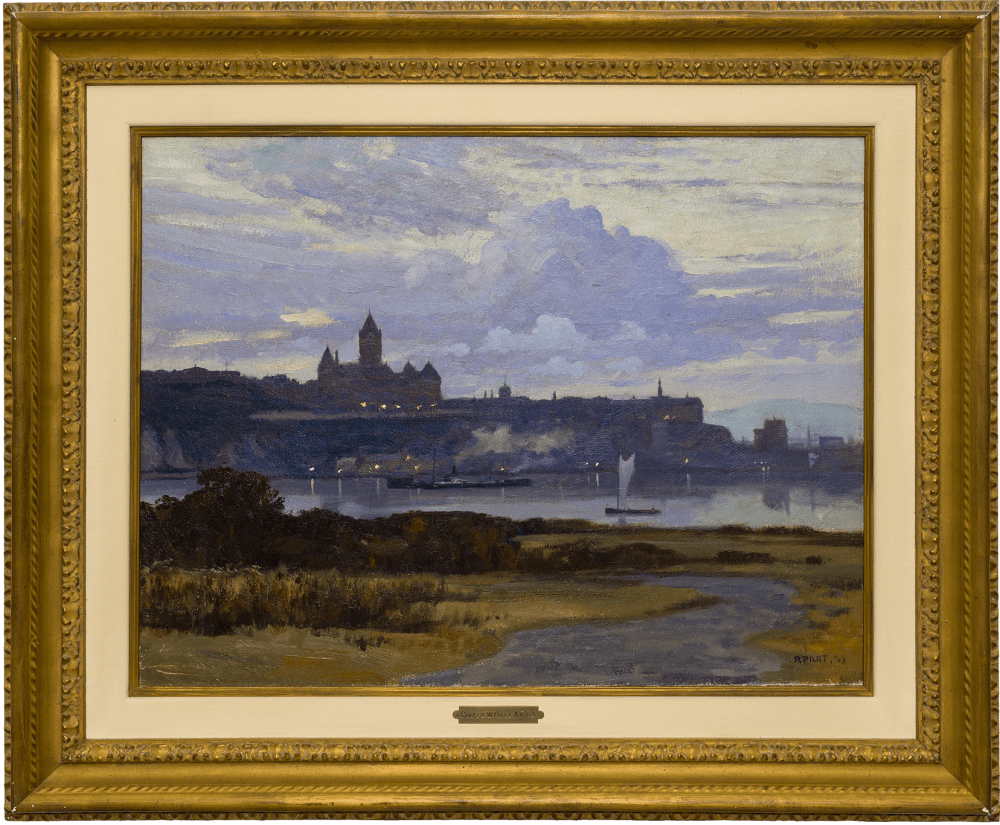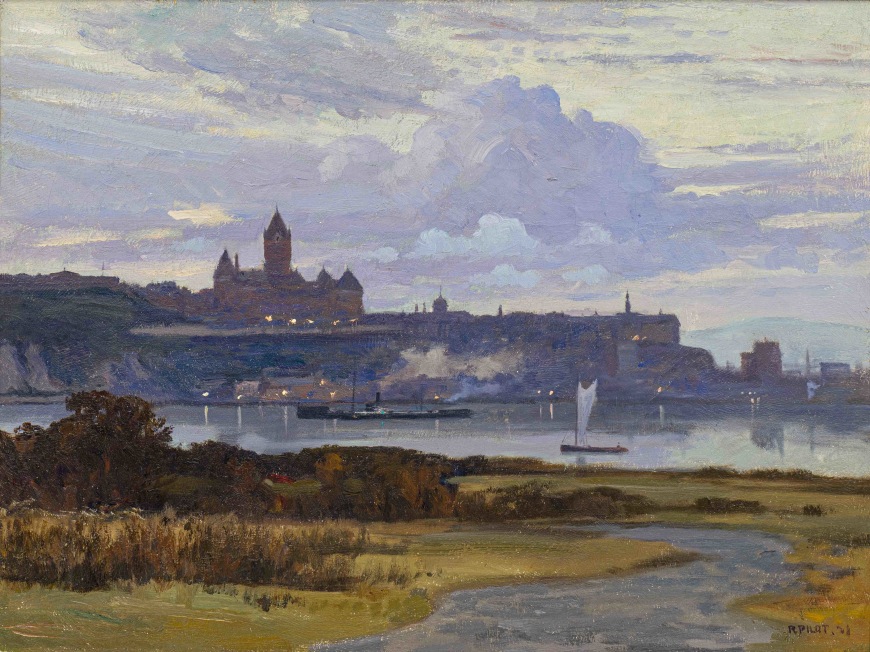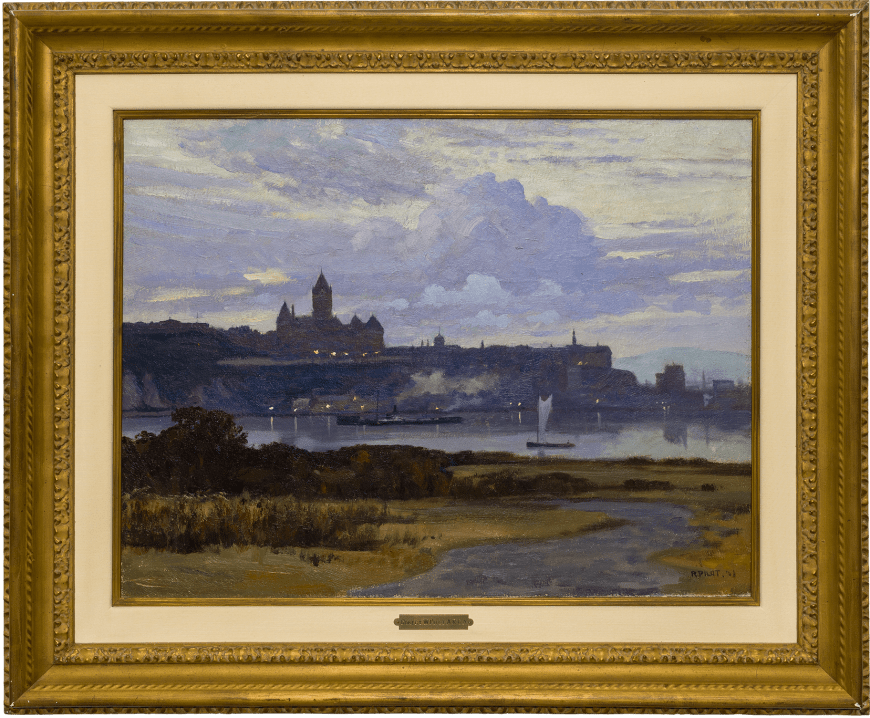-
Œuvres d'art
Robert PilotEarly Evening, Québec, 19281897-1967Oil on canvas18 x 24 inThis painting is presently on view at our Montreal gallery
45.7 x 61 cm$42,000Inscriptions
signed and dated, ‘R PILOT. 28’ (lower right)Provenance
Watson Art Galleries, Montreal
Marion Godwin, Ottawa
Catharine MacLean Dickson, Ottawa
By descent, private collection, Vancouver
Joyner/ Waddington’s, Canadian Fine Art, 28 November 2006, lot 44
Galerie Walter Klinkhoff Inc., Montreal
Property of a Distinguished Montreal Collector
Quebec City, near and far
by Mario Béland
Painter of Quebec City par excellence, Pilot captured the city in countless drawings, prints and paintings. With affection and nostalgia, he portrayed the historic, romantic city from all angles, in all seasons and at all times of the day in large panoramas and scenes of daily life. His records show that he travelled to Quebec’s capital five or six times per year. In 1929, he created prints for The Storied Streets of Quebec, a book by Blodwen Davies and published by Louis Carrier. In 1961, in an interview for Canadian Art, [1] Pilot expressed his love of the old capital: “I always come back to Quebec. I must have made sixty sketching trips down there and each time it seems to be the most paintable city. It seems to have a spell over me which is brought out by the history embraced in the city itself and also the remains of the very fine architecture and the beauty of the site itself. […] It and Paris are the two cities of the world I like the best.”
Completed shortly after his return from Paris, Cab Stand, Lower Town, Quebec is one of many winter scenes of the city painted by the artist depicting carriages with carts, berlins or sleds, which all had great commercial success. In 1924 and 1925, Pilot exhibited similar paintings at the AAM and the RCA, including Cab stand, Lévis, and Snow carts, Lévis. [2] In his only solo exhibition in Toronto, held at Laing Gallery in 1948, Cabstand, Quebec received some attention. [3] Pilot was fascinated by carriages stationed in front of fortifications and old houses or waiting for ferries at the Quebec City and Lévis docks, often setting the scenes in the evening or at night, with the silhouette of the city or the south shore in the background. Twilight, Lévis (1933) is a crowning piece of his in the genre (National Gallery of Canada). [4] Winter carriages were also a key motif throughout Kathleen Moir Morris’ career, which began alongside Cullen and Pilot.
In Cab Stand, Lower Town, Quebec, Pilot paid special attention to the blanketed carriages, the bundled-up figures, and the architecture of Lower Town, portraying a building with large green arches and two old houses, one of which has a business sign with half-obscured lettering. [5] The composition is similar to P.L. Turgeon, Épicier, Québec, also from 1924. [6] In these traditional carriage scenes and in the timeless spirit of this bygone era—a world on the verge of extinction—Pilot glorifies a long-gone past in opposition to a new, changing world. His vision of the urban landscape is anything but modern and appears to belong to another time, remaining unchanged since Morrice, as if paying homage to the great artist who died that same year.
The panoramic view of Quebec City from the south shore, specifically at twilight, was undoubtedly one of Pilot’s favourite subjects throughout his career. He exhibited many of these scenes at the AAM and the RCA during the 1920s, and later in 1947 and 1950. In fact, Québec from Lévis, presented at the RCA in 1925, was acquired as a reception piece by the National Gallery of Canada. Early Evening, Quebec, captured by a creek from the foreshore of Lévis, sets the city in the background. For this master of twilight, dusk is a magical moment that highlights the fabled, dark profile of Quebec City, with the occasional glimmer of light. Between the sky and the river, rendered in a deep blue-grey colour that contrasts with the greens and browns of the foreground, we can easily recognize, on the violet promontory, Château Frontenac and Université Laval. The middle ground depicts a loaded cargo ship spewing white smoke and a small sailboat, both cruising on the calm waters of the river. These various planes create distinctive levels that add depth to the landscape.
All his life, Pilot was sensitive and committed to the preservation of Quebec City’s architectural heritage, as shown by his interviews, lecture and text on the subject. [7] In these two paintings, we can observe the essence of Pilot’s work in Quebec City, influenced, of course, by Morrice, but also by his former teachers, Cullen and Brymner. Canadian art historians would argue that his scenes of Quebec City are his richest artistic legacy.
Mario Béland
Mario Béland holds a Ph.D. in art history from Université Laval and was curator of Art Ancien du Québec at the Musée national des beaux-arts du Québec from 1985 to 2014. He has curated, coordinated and collaborated on over 40 permanent or temporary exhibitions, some of which were accompanied by important catalogues and won prestigious excellence awards. His curatorial work includes monographs on sculptors Louis Jobin (1986) and Jean-Baptiste Côté (1996) and painters Antoine Plamondon (2005) and Napoléon Bourassa (2011). His thematic exhibitions include Painting in Quebec, 1820-1850 (1991–1992), Restauration en sculpture ancienne (1994), Les Génies de la mer (2001), and Québec et ses photographes, 1850-1908 (2008). Author of Marius Barbeau et l'art au Québec (1985) and a book on painter Eugène Hamel (2007), Béland has also published hundreds of articles, essays and notes in magazines, collective works and exhibition catalogues. A fellow of the Royal Society of Canada since 2009, Béland was the recipient of the Prix Carrière from the Société des musées du Québec in 2014, the Award of Distinguished Service from the Canadian Museums Association in 2016, and the Award of Excellence in the Professional category from the Conseil du patrimoine religieux du Québec in 2021.
______________________
Footnotes:
[1] Lawrence Sabbath, “Robert Pilot”, Canadian Art, vol. 18, no 5 (September -October 1961), p. 316–317. See also Mario Béland, “‘ Québec, mon amour’, Robert Wakeham Pilot,” Cap-aux-Diamants, no 148 (winter 2022), p. 61–62 and “ Québec, vu de près et de loin, par Robert W. Pilot,” Cap-aux-Diamants, no 149 (spring 2022), p. 61–62.
[2] In those years, he also painted Carrioles, Carré d’Youville, 1924, coll. MNBAQ, see Anne-Marie Bouchard, Art moderne du Québec. Guide des collections (Québec: Musée national des beaux-arts du Québec, 2018), 48-49.; Winter Evening, Lower Town, Quebec, 1922 and Waiting for the Ferry, Quebec, 1927, private coll. See A.K. Prakash, Impressionism in Canada. A Journey of Rediscovery (Arnolsdsche Art Publishers, 2015), 622, 634; Meeting the Ferry at Quebec (sic, Lévis), 1924, private coll.; Toronto, see Embracing Canada: Landscapes from Krieghoff to the Group of Seven, edited by Ian Thom (Vancouver/London: Vancouver Art Gallery / Black Dog Publishing, 2015), 160, and print from McCord; and also in 1929 Station de taxi, Vieux-Québec, 1924, coll. P. Lassonde; see Sarah Mainguy, “Robert Pilot,” Passion privée. L’art moderne du Québec de la collection Pierre Lassonde, edited by Anne-Marie Bouchard (Québec: Musée national des beaux-arts du Québec, 2015), 144.
[3] “Art and Artists – Robert Pilot Has Exhibit of Quality”, Globe and Mail, 10 April 1948.
[4] John R. Porter and Didier Prioul, Québec, plein la vue (Québec: Musée du Québec/Les Publications du Québec, 1994), 239.; A.K. Prakash, Impressionism in Canada. A Journey of Rediscovery (Arnoldsche Art Publishers, 2015), 636-637.
[5] Based on old photographs and a visit to this area of Lower Town, it was not possible to identify the exact location of this site, which is somewhere between Place Royale, the old Finley Market, and the Quebec City ferry to Lévis. The buildings were greatly modified or destroyed altogether during the neighbourhood’s major transformation in the 1960s and 1970s.
[6] Coll. A.K. Prakash, Ontario ; see A.K. Prakash, L’art canadien. Maîtres choisis de collections privées (Ottawa: Éditions Vincent Fortier, 2003), 204., and Une modernité des années 1920 à Montréal. Le Groupe du Beaver Hall, edited by Jacques Des Rochers et Brian Foss (Montreal/ London: Musée des beaux-arts de Montréal /Black Dog Publishing, 2015), 278.
[7] See references in Sarah Mainguy, “Robert Pilot,” Passion privée. L’art moderne du Québec de la collection Pierre Lassonde, edited by Anne-Marie Bouchard (Québec: Musée national des beaux-arts du Québec, 2015), 144.













